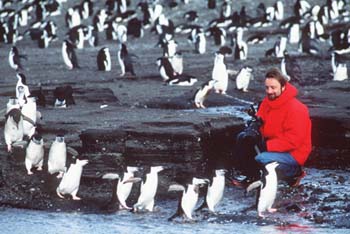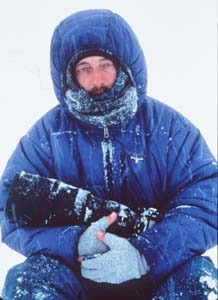![[MetroActive Arts]](/arts/gifs/art468.gif)
[ Arts Index | Santa Cruz Week | MetroActive Central | Archives ]
 Photograph by Kim Heacox Penguin Power: Frans Lanting watches a flightless parade of chinstrap penguins to the sea. Natural Focus Acclaimed nature photographer Frans Lanting hurries to document the Earth's shrinking biodiversity By Rob Pratt THE ELEMENT that always stands out in the work of nature photographer Frans Lanting--the mystique that sets his images of creatures and habitats far above the rest, earns him cover-shot credits in scientific journals like National Geographic and Geo and wins him honors and acclaim worldwide--shows in his face on the other side of the camera lens. His mournful countenance, his intent eyes and his neutral expression hint at his drive and determination. In a way, they tell of his profound commitment to the natural world and his fear that he may be one of the last people to see many of the sights and scenes he chronicles. Those are the details that make Lanting's photographs instantly recognizable. More than images of animals in their natural environment, his works somehow capture the inner life of his subjects: the preflight anxiety of a herd of impala, the solitary contemplation of a bonobo monkey, the cathedral-like majesty of a group of African elephants. These aren't photographs of animals, of creatures who stand below humans in the hierarchy of life on Earth. His subjects aren't charges that humanity must steward carefully. Through Lanting's lens, these creatures are peers, each species a sovereign nation with equal claim to representation in the vast congress that is the Earth's ecosystem. "I'm prolific because I feel driven," Lanting, who lives in Bonny Doon, says during a phone interview scheduled between early November trips to Europe for a book tour and across the United States for a lecture tour. "My mission is to create experience among the public for things I think are going under."
Photograph by Frans Lanting
FOR THE PAST couple of years, Lanting's fieldwork has taken him from the East Coast of the United States to Central and South America, to Australia for a major story on biodiversity that appeared in National Geographic in February and to Antarctica, where he investigated the lives of the many varieties of penguins that live among fragile landscapes of ice for his latest book, Penguin. For his annual Thanksgiving weekend lecture at 4 and 7pm Sunday at Cabrillo College, Lanting talks about penguins and the grave threats to their desolate habitat. A benefit for the Santa Cruz City Museum of Natural History, Lanting's show, which he has presented almost every year since 1990, came about from his long association with the museum. John Anderson, who when he retired last year had served for 25 years as the museum's assistant curator, says that the first collaboration dealt with Lanting's work on coastal sanderlings. The book that resulted, 1982's Feathers, marked the foundation of his style and established his reputation as a world-class nature photographer. "He used to come to the museum to look at our specimens closely before he went into the field," Anderson says. "After he became famous, he went gallivanting around the world for seven or eight years, and we didn't see him much. "He has an amazing perspective on capturing nature," Anderson adds. "His vision is unique among nature photographers." "What I do is to bring the wildness of nature to people," Lanting says of his style. "Penguins make it a little easier. Any animal that goes upright and has two legs starts out with a lot of sympathy." But, he continues, that also means that penguins get stereotyped as peoplelike even though they make unique adaptations to their rugged environment. In Penguin, Lanting tells of finding trails that the birds have followed for thousands of years, watching as they swim to fishing grounds through "a deadly gauntlet" of sea lions on the hunt and seeing a nest of chicks waiting for a parent's call that mealtime has come. And his photographs study upward of a dozen varieties--lithe rock hoppers, gold-plumed macaronis and burly emperors--each with individual ways of facing their world. Penguin, though, goes deeper still. Lanting shows birds on a wind-swept, icy plain hunched down, backs to the gale, waiting out the weather, or huddled down, wings over the head like a feathered shield. It's almost as if the birds were trying to say that enduring such a harsh environment isn't all fun and games. "When I was in the field, I'd spend time with individual penguins ... and that leads to highly individual photographs," Lanting explains. "I found that different clans of penguins would have different characteristics and adaptations. A penguin is not a penguin is not a penguin. The whole book is set up as a vacillation between individual penguins, their group characteristics and their environment." It's a troubled environment, he continues. Global warming threatens the margin between ocean and ice where they live. Soon their habitat--like so many unique habitats on Earth--may simply disappear. "Penguins live in a knife's-edge environment," he adds. "As things get warmer, it's changing. Emperor penguins, who hardly ever touch land all their lives, need that sea ice. When it breaks off, they're lost because they're hardwired to use that particular environment." FROM THE BEGINNING of his experiments with photography, Lanting has turned his lens on threatened environments. In the early '70s and just out of college, he first came to the United States from his native Rotterdam, Netherlands, for a holiday of hiking and photographing national parks. But when he returned home, the results didn't suit him, so he focused his intense determination on learning technique, using as his subjects the wildlife in the Dutch countryside. Coming to Santa Cruz to study environmental planning at UC-Santa Cruz (which he abandoned to pursue a career in photography), Lanting has kept Santa Cruz as his home base, now living and working with his wife, writer and frequent collaborator Christine Eckstrom, atop a hillside north of town with a panoramic view of Monterey Bay. Just as the sanderlings he studied in the late '70s faced encroachment from a growing city of Santa Cruz, all of Lanting's subjects lately are threatened by humans. "The issues of biodiversity and loss of species are among the great issues of our time," he says. "It's a staggering problem, and the major factor in the loss of biodiversity ... is that every person makes a dent in the Earth's resources, and we consume far more than our share." Frans Lanting presents his slide show and talk "Penguin" at 4 and 7pm Sunday (Nov. 28) at Cabrillo College Theater, 6500 Soquel Dr., Aptos. Tickets are $5.50-$9. (420.6115) [ Santa Cruz Week | MetroActive Central | Archives ]
|
From the November 24-December 1, 1999 issue of Metro Santa Cruz.
Copyright © Metro Publishing Inc. Maintained by Boulevards New Media.
 Cold Call: Lanting's photographic quests often take him to the most inclement parts of the planet.
Cold Call: Lanting's photographic quests often take him to the most inclement parts of the planet.